#spaceborne life form
Explore tagged Tumblr posts
Text

"Bioshipyard" by James Bielby.
9 notes
·
View notes
Text
Chewie, check if there are any more of them...chewing on the power cables...

Tim Hildebrandt
#tim hildebrandt#brothers hildebrandt#space art#spacecraft#cockpit#control center#dragon#spaceborne life form
173 notes
·
View notes
Text

After the invention of the Zero Point drive, the human race rapidly spread out across the stars, from the solar hub to the fringworlds. However, space is a hostile place, and habitable worlds are quite rare. As a result, many new variants of humanity have emerged, modifying themselves in order to survive the strange, alien environments they find themselves in… or sometimes just for fun. Pictured here are but a small sample of variant human subspecies…
Titanian: Corpulent, furry human variant adapted to extremely cold environments; initially developed to better withstand the harsh conditions of Titan, Saturn’s icy moon, but have since spread to other frozen worlds; typically inhabit pressurized underground tunnel cities carved into the ice.
Spaceborne: Tall, lanky variant with prehensile feet and tails, optimized for life in microgravity; one of the oldest variant groups, created during the earliest days of the first interstellar age; designed to live aboard long-distance exploration/colonization vessels.
(Artist’s note: these folks are heavily influenced by @jayrockin ‘s tailed spacers - go check out their stuff, it’s awesome!)
Rock Rats: Another early variant designed to live and work in the asteroid belt; short, stocky bodies built for navigating the narrow ducts, crawlspaces, and passageways common aboard mining vessels, as well as the labyrinthine tunnels of their hollowed-out asteroid homes; “rock rat” is a colloquial term, originally derogatory but has since been reclaimed.
Voidwalkers: Highly-modified variant designed to survive in the vacuum of space; originally created by a dubiously-ethical megacorp to serve as an orbital labor force; have since gone on to form their own society of nomadic spacefaring clans, offering their unique services to ships and stations in need.
Vamps: A collective of eccentric horror fiction enthusiasts who deliberately bio-modded themselves to resemble their favorite imaginary bloodsuckers; long-lived, sensitive to sunlight, crave the taste of blood; actually pretty harmless, as they tend to subsist on synthetic blood substitutes.
(Artist’s note: apparently its a weirdly common thing for vampires to inexplicably show up in otherwise grounded hard-sf settings, so I decided to jump on the bandwagon!)
SmartPets: Bipedal uplifted animals with trace amounts of human DNA, available in a wide variety of species; created and sold by a division of the same megacorp as the voidwalkers; designed to be the ultimate domestic companion; infamously advertised with the tagline “man’s best friend just got better.”
30 notes
·
View notes
Text
Record of a Spaceborn Few
The “why I want you to read this”: Look, you'll read it in an afternoon and then I will move on to constantly telling you to read some other sci-fi book, because it's an incredibly varied genre just like any other and I promise you you do not hate all of it. This is a book about what happens to a community formed by adversity when the adversity goes away. It's about identity, diaspora and growing up in a shitty town in the middle of nowhere. Also it takes place on a spaceship.
(This made me laugh very hard btw, and applause)
This book I think was largely not for me. It DID suffer for coming between The Iron Tracks: A novel about revenge and what it means to carry it around, and what you do when it is done, written by a Holocaust Survivor, and, The Power of the Dog: A Western novel about work and discipline and judgment as forms of self-hatred, and what it all comes to.
Record is about, like, baking nice bread in space and teenagers looking for jobs. Feeling lonely. Finding purpose. It’s very much a slice of life novel. Which I CAN like, but the characters have to be very compelling for me to get into that, and this didn’t get there. I was bored much of the time, because the prose never elevated the story above, “wow we really should have a cultural class for immigrants! I’ll volunteer!”
Thing I liked the best: In SOME moments, this is a book about living in highly rural areas, and what it means to have that as a part of you, and how to save it. these are the moments I connected it with it! In moments there is an intense connection with the DIFFICULTY of the choice, and the hardship of the land, that I found truly incredible. A few lines about it I marked out about being specifically beautiful. I think I actually would have liked the book more if if engaged more with “The Fleet I live in now is not the Fleet i fucking grew up with, and I am MAD about that, and I am struggling with that!” because in the brief moments it engaged with that I was screaming “Yes! This also has happened to me and I’M MAD AS HELL!” and then it was like, “Everyone moving there wants to engage culturally with the established culture, just love them uwu” I was shaking her by though shoulders going “ I am BEGGING you to go talk to people from rural cultures in a meaningful way” because it’s ALMOST THERE!!
Thing I liked the least: BOY, Chambers sure wants to make xe/xyr happen instead of they/them. This is essentially settled law in modern English. It’s done. They/them has existed for MANY MANY YEARS and is a natural and normal way for English speakers to reflect the sentiment. It had the same effect on me as a modern author saying “his or her,” which for many years was the correct way but now, is not. Because, the law has been settled.
But yeah, mostly it was a slice of life novel with a bent toward a nigh-naive way of looking at humanity in this near perfect space kibbutz that I agree with on paper but I also know that “sometimes adults chose NOT to take jobs, and there was SHAME :’((, so people discovered their passion for sorting cargo” isn’t quite realistic enough for me to engage with the world. To touch on the above, with the Fleet changing, and dying, and the upset behind that, I would have loved more engagement with that, but it would have required Chambers to LET THE FUCK GO of her quasi-Startrekkian brightsidedness.
I am being very serious when I say a major plot line is a teenager figuring out the job he wants and also not to do drugs.
7 notes
·
View notes
Text




2023 was a wonderful reading year for me, after a long period of burnout. Here are my highlights, all very warmly recommnded.
Index, A History of the, by Dennis Duncan: Fun take on book history. Takes you into all sorts of topics like alphabetical order in different cultures, and how people used books when they were scrolls. Also the tricky time when books had indexes but not page numbers!
Piranesi by Susanna Clarke: Small but perfectly formed fantasy. Brought back to me the childhood feeling of reading stories where another world is hidden just out of sight.
Record of a Spaceborn Few by Becky Chambers: The love story of a community, as people face change and children grow up, and re-examine their way of life. Beautiful. Can be read as a stand-alone.
The End of Everything by Katie Mack: To explain all the ways the universe might end, this takes you through lots of astrophysical concepts. Accessible to readers as scientifically illiterate as me. I still can’t cope with Boltzmann brains, though.
Entangled Life by Merlin Sheldrake: The weird world of fungi, plant roots and soil. Eye-opening!
Lincoln in the Bardo by George Saunders: A moving story of loss and regret, set in a cemetery. I just wished for an author’s note with info about the memoirs from which he drew quotations.
The Silk Roads by Peter Frankopan: I’m only 1/3 through but it is very long, so safe to say this is really good! Super readable and de-centring Europe makes for an illuminating perspective on world history.
And a shout out for Everything You Need to Know about the Menopause (But Were Afraid to Ask) by Kate Muir. Not exactly a fun read, but a really valuable book.
2 notes
·
View notes
Text
The cover for the 1982 Timescape edition of The Voyage of the Space Beagle.
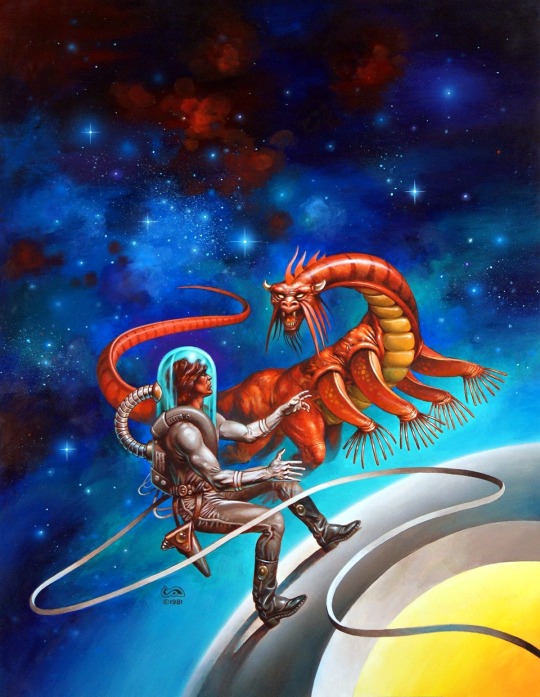
Clyde Caldwell
#clyde caldwell#a e van vogt#the voyage of the space beagle#discord in scarlet#astronaut#alien#spaceborne life form#ixtl
73 notes
·
View notes
Photo

The Anti-Atlas Mountains of Morocco formed as a result of the collision of the African and Eurasian tectonic plates about 80 million years ago. This collision destroyed the Tethys Ocean; the limestone, sandstone, claystone, and gypsum layers that formed the ocean bed were folded and crumpled to create the Atlas and Anti-Atlas Mountains. In this ASTER image, short wavelength infrared bands are combined to dramatically highlight the different rock types, and illustrate the complex folding. The yellowish, orange and green areas are limestones, sandstones and gypsum; the dark blue and green areas are underlying granitic rocks. The ability to map geology using ASTER data is enhanced by the multiple short wavelength infrared bands, that are sensitive to differences in rock mineralogy. This image was acquired on June 13, 2001 by the Advanced Spaceborne Thermal Emission and Reflection Radiometer (ASTER) on NASA's Terra satellite. With its 14 spectral bands from the visible to the thermal infrared wavelength region, and its high spatial resolution of 15 to 90 meters (about 50 to 300 feet), ASTER images Earth to map and monitor the changing surface of our planet. ASTER is one of five Earth-observing instruments launched December 18, 1999, on NASA's Terra satellite. The instrument was built by Japan's Ministry of Economy, Trade and Industry. A joint U.S./Japan science team is responsible for validation and calibration of the instrument and the data products. The broad spectral coverage and high spectral resolution of ASTER will provide scientists in numerous disciplines with critical information for surface mapping, and monitoring of dynamic conditions and temporal change. Example applications are: monitoring glacial advances and retreats; monitoring potentially active volcanoes; identifying crop stress; determining cloud morphology and physical properties; wetlands evaluation; thermal pollution monitoring; coral reef degradation; surface temperature mapping of soils and geology; and measuring surface heat balance. Dr. Anne Kahle at NASA's Jet Propulsion Laboratory, Pasadena, California, is the U.S. Science team leader; Bjorn Eng of JPL is the project manager. The Terra mission is part of NASA's Earth Science Enterprise, a long- term research effort to understand and protect our home planet. Through the study of Earth, NASA will help to provide sound science to policy and economic decision-makers so as to better life here, while developing the technologies needed to explore the universe and search for life beyond our home planet. Size: 28.7 x 29.4 km (17.8 x 18.2 miles) Location: 29.4 deg. North lat., 8.9 deg. West long. Orientation: North at top Image Data: ASTER bands 4,6 and 8. Original Data Resolution: 30 m Date Acquired: June 13, 2001
3 notes
·
View notes
Text
i just reblogged two posts in a row that i think are basically about the same thing. sci fi setting where whalefall ecosystems for spaceborne life form around spaceship wrecks
6 notes
·
View notes
Text
9 Ways NASA Solves Water Problems Around the Globe - Technology Org
New Post has been published on https://thedigitalinsider.com/9-ways-nasa-solves-water-problems-around-the-globe-technology-org/
9 Ways NASA Solves Water Problems Around the Globe - Technology Org
World Water Day reminds us not to take for granted the clean water we rely on. And in space, we treat every drop as a precious resource, prompting investment in technologies to conserve and reuse. Now, these innovations are hard at work here on Earth!
From discovering hidden water sources to advancing purification techniques, check out the different ways NASA is changing how we use and manage the water in our lives.
Water – illustrative photo. Image credit: Pixabay (Free Pixabay license)
Microbial Check Valve
A water disinfection unit known as the Microbial Check Valve, which passes water through a bed of iodinated resin, was invented in the 1970s for drinking water on the space shuttle, and it was updated to be self-regenerating in the 1990s for use on the International Space Station.
A mat of ecoSPEARS spikes filled with a NASA-developed formula removes toxic polychlorinated biphenyls (PCBs) without damaging the aquatic ecosystem. Image credit: Gagan Cambow, ecoSPEARS
The Microbial Check Valve is now central to water purification units that have been deployed across India, Mexico, Pakistan, and other countries, including hundreds of remote village locations. It also led to the popular DentaPure cartridge that has been purifying waterlines in dental instruments around the world for almost 30 years.
Radar Imaging to Locate Well Sources
In 2002, an exploration geologist who was using Earth imagery from NASA’s Spaceborne Imaging Radar to locate underground resources realized the images could also lead him to subterranean moisture.
He set about developing the WATEX System at his company, Radar Technologies International, and in 2013 the system uncovered a vast aquifer with tens of trillions of gallons of water beneath a parched corner of northwest Kenya. The technology has now helped to place 2,500 wells, many of them in drought-stricken regions, with a 98% success rate for finding water.
Regardless of the amount of winter ice cover, the waters off of the Alaskan coast usually come alive each spring with blooms of phytoplankton. These blooms can form striking patterns of blue and green seawater, such as those visible in this image of the Chukchi Sea acquired on June 18, 2018, by the Operational Land Imager (OLI) on Landsat 8. Image credit: NASA/U.S. Geological Survey/Norman Kuring/Kathryn Hansen
Water Testing App
After NASA developed a simple coliform bacteria test for astronauts to test water on the International Space Station, an agency environmental engineer worked with his wife and a software engineer to develop the mWater smartphone app that let users carry out a coliform bacteria test based on the one NASA had created, as well as other simple water tests.
The app could then share the results through mapping software. Governments, nonprofit organizations, and water providers in 180 countries now use mWater test kits and apps to test drinking water and record, share, and track water data.
Orbital Systems’ Oas shower is the world’s first water-recirculating shower. It was inspired by a university’s partnership with NASA and is enabled by NanoCeram filter technology, which NASA helped fund with an eye toward improving astronaut life-support systems. Image credit: Orbital Systems
Filter Born from Astronaut Drinking Water Standards
Since its early days, NASA has explored various water purification technologies to provide drinking water for astronauts. In the early 2000s, with SBIR funding from the agency, Argonide Corporation optimized a filtration technology called NanoCeram, which uses a combination of positively charged microscopic alumina fibers and activated carbon to trap microorganisms and other contaminants.
NanoCeram has since been incorporated into lab-quality filters, water bottles, portable humanitarian units, industrial water purification, and even a water-recycling shower.
The Pod+ water bottle from nkd LIFE uses a filter medium developed and tested with the help of NASA funding, known as NanoCeram and now marketed as Disruptor, to purify water on the go, removing 99.97% of contaminants and accommodating a high flow rate. Image credits: nkd LIFE Ltd.
Microbial Contaminant Sterilizer
An early water purification technique NASA explored was the use of silver ions to neutralize microbial contaminants. In the lead-ups to the Apollo missions and then the space shuttle, the space agency commissioned the design and construction of silver ion generators to sterilize the water that was a by-product of the spacecrafts’ fuel cells, ensuring it would be safe to drink.
NASA never flew the technology, but the agency published details about the inventions, which have provided a basis for commercial product lines including in-home water filters and water softeners, as well as systems for pools, spas, cooling towers, ponds, boilers, and hospitals.
The Puronics Defender whole-house water conditioner uses silver-ion technology based on work NASA did in the run-ups to the Apollo and space shuttle missions. Positively charged silver ions neutralize bacteria in the unit’s filter beds. Image credit: Advanced Cascade Water Systems Inc.
Groundwater Remediation
After NASA discovered large amounts of chlorinated solvents in the groundwater around a historic launch complex at Kennedy Space Center, scientists at the center came up with a unique method for removing these pollutants – which are now banned but were also once used by a variety of industries.
In the 20 years following its patenting, NASA has licensed this formula, known as emulsified zero-valent iron, or EZVI, to several businesses that have used it in environmental cleanups all over the country. One of the Kennedy engineers later invented a similar technology for removing polychlorinated biphenyls, or PCBs, another common pollutant, from groundwater.
A company that formed to license that technology in 2017 is already carrying out cleanups around the world.
Brett Baker checks a sprinkler on his family’s pear farm. Farms like his in California’s Sacramento-San Joaquin River Delta have to monitor their water use, but accurate estimates were nearly impossible until the advent of OpenET, a platform that uses Landsat data to determine the total amount of water evaporated and transpired from a given area. Image credit: Environmental Defense Fund
Filtration by Osmosis
In 2007, NASA learned of a Danish company working on water filtration based on membranes infused with aquaporins – the proteins that let water pass through cell membranes one molecule at a time.
Always interested in better water purification technology, NASA became the company’s first paying customer, funding the development of prototypes and then working with the European Space Agency to test the membranes on the International Space Station.
The company, Aquaporin A/S, now sells under-sink water purifiers in Europe and India, and its forward osmosis modules are cleaning industrial and municipal wastewater.
In the gray water reclamation system at Ames Research Center’s Sustainability Base, the two beige Aquaporin HFFO14 forward-osmosis modules on the left have as much filtration capacity as the entire legacy system on the right. Image credit: Aquaporin A/S
Tools to Monitor Farm Water Use
The best way to calculate agricultural water use isn’t to measure how much water is diverted to cropland, but to measure evapotranspiration from the plants and soil.
A tool called EEFlux, built by researchers in the 2010s, was among the first to use Earth-imaging data from NASA-built satellites to calculate evapotranspiration. It helps manage water resources in dry areas like California.
A similar commercial method from Tule Technologies has helped some California farmers cut their water use by up to half. In 2021, NASA and partners debuted the OpenET online platform that lets users calculate evapotranspiration anywhere in 17 western states. The tool is helping farmers and local governments work together to conserve scarce water resources.
Thrusters Powered by Electrolyzed Water
For all the ways NASA helps purify and conserve water on Earth, it is still, first and foremost, the world’s premier space agency. As such, it has also worked to use water as a rocket fuel – one that could be obtained on other planets, moons, and asteroids for deep-space travel.
Millennium Space Systems bought Tethers Unlimited’s first three water-electrolysis engines by helping to fund the technology’s final stage of development through NASA’s Tipping Point solicitation. The thrusters were to fly on Millennium’s Altair small satellites. Image credit: Millennium Space Systems
An electric current can separate water into hydrogen – NASA’s rocket fuel of choice – and oxygen, which helps it burn. In 2019, the company Tethers Unlimited unveiled the first commercial thrusters powered by electrolyzed water, which it developed with years of funding from the space agency.
The technology is first going into commercial satellites, which will use it to maintain or change their orbits.
Source: NASA
You can offer your link to a page which is relevant to the topic of this post.
#altair#app#apps#asteroids#astronauts#Bacteria#Blue#Born#carbon#cascade#cell#Cells#Chemistry & materials science news#Classical physics news#clean water#construction#cooling#data#defense#Design#details#development#Developments#disinfection#disruptor#drinking#drinking water#earth#Engineer#engineers
0 notes
Text

A page scanned from Eerie #33. Art by Larry Todd.
#larry todd#warren publishing#eerie magazine#astronaut#spaceborne life form#space art#what's an astrolith anyway?
15 notes
·
View notes
Photo
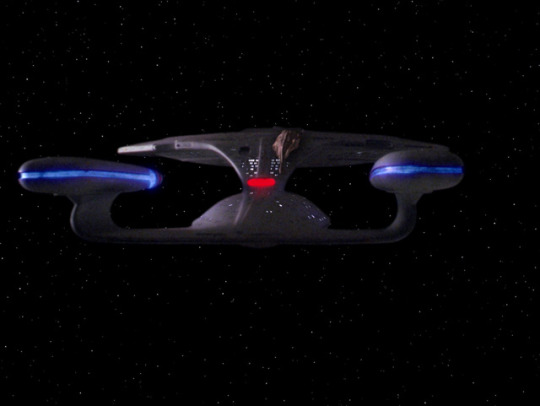
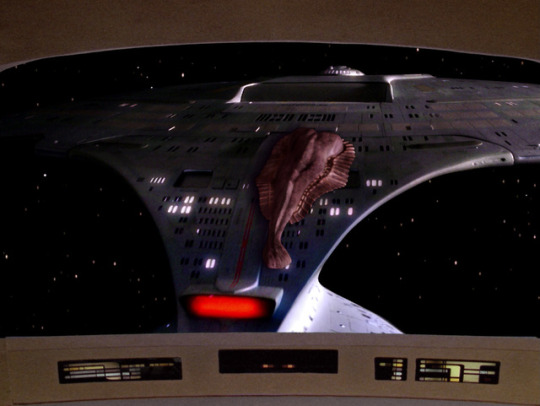

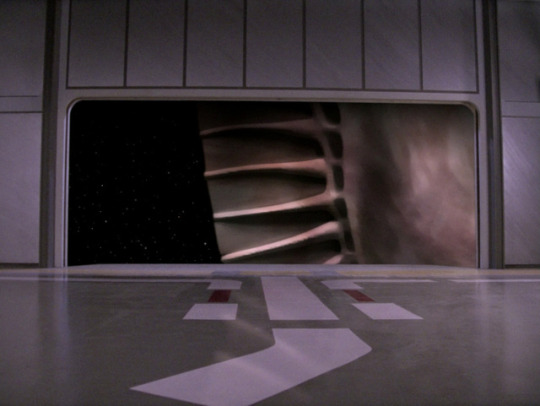
Star Trek: The Next Generation, Episode #90: “Galaxy’s Child” (1992).
The view of the life form from inside the shuttle bay is one of those things I find very unnerving for reasons that are difficult to articulate.
#star trek#tng#galaxy's child#dan curry#rhythm & hues#spaceborne life form#creature#monster#unsettling
3 notes
·
View notes
Text
Racism and Becky Chambers
I've been telling some people lately that I'm no longer into popular sci-fi author Becky Chambers' writing because I'm put off by the racism. When I googled around for some critique about this, I found that there wasn't much, so I wanted to take the time to explain in some detail why I feel this way.
The Wayfarers series has an overall problem of "post-racial" sci-fi in which humanity has supposedly intermixed so much that everyone is everything and race doesn't exist anymore. I am completely in favor of science fiction that depicts a future without racism, but this is a very short-sighted way to do so. A future without racism isn't a future where all of humanity is homogenized; it's a future where all types of humans and all of our cultures are equal, all respected, all thriving. (For an example of science fiction without racism that doesn't homogenize humanity and culture, see the Twilight Mirage season of the podcast Friends at the Table.) This vision of how to overcome racism reminds me of color-blind racism, in which people claim to not be racist because they don't see race. By this same logic, if everyone is mixed, then we're all the same race and there's no racism.
More specifically in the Wayfarers series, I'm troubled by the tradition of the Exodus fleet shown in Record of a Spaceborn Few in which families get their surnames from the surname of the first family to live in the family quarters they do, regardless of their relationship to that family. This cultural practice means that any family living in the quarters first inhabited by, say, the Achebe family, would have the surname Achebe, even if they have no connection to Igbo culture. There is no examination in the book of what this might mean or how it might be troubling. This feels like another form of color-blind racism: we're all the same, so any family can have any surname and it doesn't matter.
There's another form of crypto-racism in the Wayfarers series and A Psalm for the Wild-Built that is based on a deeply settler-colonial perspective and an ignorance of indigenous ways of life. In the Wayfarers series, Earth has been set aside as a nature reserve without humans so it can recover from pollution and climate change. In A Psalm for the Wild-Built, half of the terraformed moon where people live in the future is also set aside as a human-free nature reserve. The clear message here is that Chambers believes that humans and Terran ecosystems are better off if we interact with them as little as possible. This belief is false, and it is based on a settler-colonial understanding of ecology. Indigenous peoples have positive, healing relationships with their traditional lands, which are deeply beneficial both to the people and to the ecosystems they tend. And if you can't take indigenous people's word for that, there are Western scientific studies which have shown that indigenous harvest practices have a positive impact on the plants they harvest. Becky Chambers' ecological "utopia" in which humans and Terran ecosystems do not interact with each other is in fact a dystopia.
Usual disclaimer that if you enjoy Becky Chambers' novels, you can continue to enjoy them; I am not coming for your faves. I just think it's important to point this out.
175 notes
·
View notes
Text
this got me imagining spaceborne life forms that live on starship hulls like barnacles on a wooden ship, slowly spreading and eating away the material, and the low ranking folk who have to go out in a space suit and clean them off
[starship battle]
CAPTAIN: We're outgunned! Our only hope is to hide in that nebula
ENSIGN WHOSE JOB IS CLEANING NEBULA GUNK OFF THE HULL: what if instead we made peace with our inevitable deaths?
809 notes
·
View notes
Note
There is the theory of convergent evolution. The idea that life solves problems in relatively the same ways leading to the same outcomes despite the locations of the species in question and their ancestry. The idea is that there's only so many ways to put together the components we know about so thinks kinda sort out bell curve style from least likely to most likely. Upright stance for a more complete survey of one's surroundings and possible climbing benefits. The limits of transmitting information from ocular structures to a brain for adequate response timing, square cube laws, and so on.
That all said, if we're talking a race that reproduces by means of harvesting a nondescript energy and terrestrial matter from planets to the point the planets structural integrity comes to be at risk. That are made of 'hard light' projected by a singular, purely physical construct, and are otherwise entirely malleable in form, thus able to adapt to any planetary conditions... I'd say that breaks down to 3 possible outcomes in my mind
1) Artificial, constructed by another race with the intent of being an army/work force that has long outstepped their creators.
2) Artificial, the next step in the evolution of a species that has transcended organic status and now exist as energy tethered to physical processors, designing the means of reproducing new personalities for freshly crafted cores.
3) Natural, possible panspermia, spaceborne life that learned to live on planets with no real or surviving planet of origin. The natural evolution of a creature that subsist primarily on light, generates its own gravity, and evolves the ability to not only reshape it's light body but craft light tools from themselves.

Well I did not expect that, and that's a lot of info.
I don't really wanna get into a debate here, with anon because I would rather do that in DM or personal answers(I can't do personally answer to anon). That being said, First, I would like to point out that the theory of convergent evolution, wasn't probably taking non-organic lifeforms made out of hard-light and minerals in to a count.
Second, all three of your possible outcomes are all about how gems are come to be and don't explain much about the reason behind the physical similarity between gem and human(and I believe gems are all artificial, if any was natural I'd say it would be only White Diamond).
Anyway, it was an interesting theory and discussion, however, I won't be answering another anon asks about this human evolution and Pearl designing them, unless they are sending asks in non-anon setting or DM me.
It's just getting too deep for my liking to be put on my Tumblr page. It was just a fun idea I had for the comic, ya know. :/
18 notes
·
View notes
Text
The Zygor from Action Comics #316, pencilled by Jim Mooney.
Thanks to P. S. Shaw for linking me to a blog entry on this issue by Deejay Dayton.

287 notes
·
View notes
Text
10 Ground-breaking Earth Satellite Images from 2018
In 2018, our satellites captured beautiful imagery from throughout the solar system and beyond. However, some of our favorite visualizations are of this very planet. While this list is by no means exhaustive, it does capture some Earth satellite images from this year that are both visually striking as well as scientifically informative. This list also represents a broad variety of Earth’s features, as well as satellite instrumentation. Take a journey with our eyes in the sky!
10. Hurricane Florence
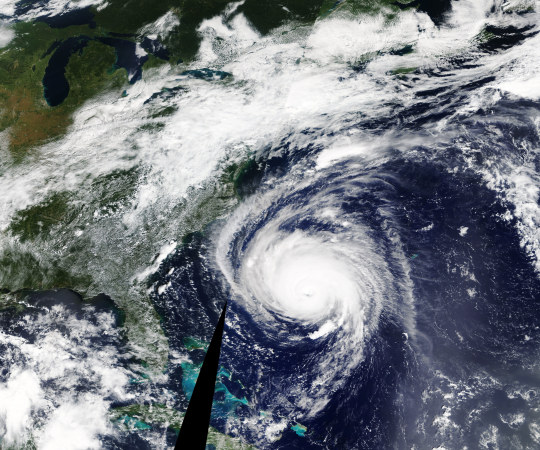
Before making landfall, Hurricane Florence churned in the Atlantic for a full two weeks — making it among the longest-lived cyclones of the 2018 season. When it finally did hit land on Sep. 14, the storm devastated the southeastern U.S. coast with intense winds, torrential rains and severe flooding.
This natural-color image was acquired by MODIS on the Terra Satellite on Sep. 12, 2018.
Images like this, as well as other satellite information, were used to anticipate the impact of the storm. Our Disasters Program created flood proxy maps that were shared with the Federal Emergency Management Agency (FEMA) and the National Guard to estimate how many and which communities would be most affected by the storm, in order to help prepare recovery efforts ahead of time.
9. Australia’s Lake Eyre Basin

The Lake Eyre Basin covers one-sixth of Australia and is one of the world’s largest internally draining river systems. However, the rivers supported by this system are ephemeral, meaning that they only run for short periods of time following unpredictable rain — the rest of the time, the Basin is a dry, arid desert.
However, when the heavy rain comes, the basin erupts in an explosion of green. In this false-color image captured by the Operational Land Imager (OLI) on Landsat 8 on Apr. 25, 2018, you can see how the vegetation completely envelops the spaces where the water has receded. (Flood water is indicated by light blue, and vegetation is indicated by light green.)
Satellites are an excellent tool for tracking greening events that are followed by flooding. These events offer opportunities for predictive tools as well as recreation.
8. Alaska’s Chukchi Sea

A Monet painting comes to life as the Chukchi Sea swirls with microscopic marine algae.
This image was captured off the Alaskan coast by OLI on Landsat 8 on Jun. 18, 2018. After the Arctic sea ice breaks up each spring, the nutrient-rich Bering Sea water mixes with the nutrient-poor Alaskan coastal water. Each type of water brings with it a different type of phytoplankton and the surface waters have just enough light for the algae to populate and flourish. The result is these mesmerizing patterns of turquoise and green.
This image represents one piece of much larger, incredibly complex ecosystem. While one would not normally associate the breaking up of sea ice with phytoplankton blooms, it is an intricate process of the phytoplankton life cycle. The size of the blooms have varied greatly from year to year, and experts are unsure why. Images like these can help scientists track the development of these blooms and link it to other environmental changes.
7. Hawaii’s Kilauea

Sometimes fresh lava is best viewed in infrared.
This false-color image of Kilauea, captured by OLI on Landsat 8 on May 23, 2018, shows the infrared signal emitted by lava flowing toward the sea. The purple areas surrounding the glowing lava are clouds lit from below, indicating that this image was taken through a break in the clouds.
The Puʻu ʻŌʻō Kupaianaha eruption has been continuously spewing red-hot lava since 1983, making it the longest eruption at Kilauea in recorded history. However, new fissures opened up this year that forced many to evacuate the area. Hawaii’s largest lake evaporated in hours and hundreds of homes were destroyed in Vacationland and Kapoho.
Imagery, seismometers and ground-based instruments were used to track the underground movement of magma. Infrared imagery can be incredibly helpful in disasters like this when you to view data that cannot be observed with the naked eye.
6. California’s Woolsey Burn Scar
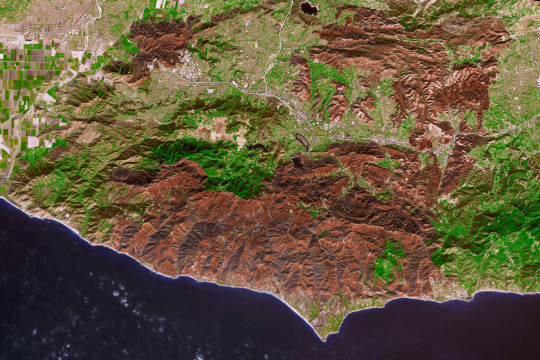
Nothing quite encapsulates the destruction of a wildfire like a photo from outer space.
This image of the Woolsey Fire aftermath in Southern California was captured on Nov. 18, 2018 by the Advanced Spaceborned Thermal Emission and Reflection Radiometer (ASTER) on the Terra satellite. This false-color infrared image has been enhanced to clearly show the burned vegetation (indicated by brown) and the vegetation that survived unscathed (indicated by green).
The Woolsey Fire clearly left its mark, with almost 152 square miles (394 square km) and 88% of the Santa Monica Mountains National Recreation Area badly burned. Images like this one can assist fire managers in the area plan for recovery.
5. Bangladesh’s Padma River
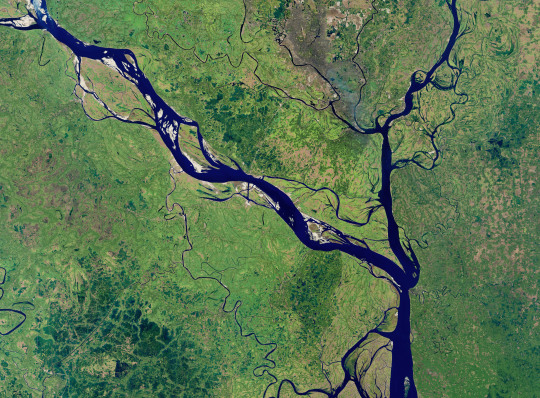
As the years go by, the Padma River grows and shrinks, twists and turns. It never has a fixed shape, and as a result, thousands of people must regularly adapt to the constant changes in the river’s 75-mile (130-km) shoreline.
This image captured on Jan. 20, 2018 by OLI on Landsat 8 depicts one of the major rivers of Bangladesh. For thirty years, scientists have been tracking the erosion of the river with satellite imagery. Combinations of shortwave infrared, near infrared, and visible light are used to detect differences year-to-year in width, depth, and shape of the river. Sometimes the river splits off, but then rejoins again later. These patterns are created by the river carrying and depositing sediment, shaping the curves of the path of water.
Monitoring the Padma River is going to become especially important as a new bridge development project advances in the Char Janajat area. Although the bridge will most certainly help shorten travel times for citizens, nobody is quite sure how the river erosion might affect the construction and vice versa.
4. Alaska’s Yakutat Glacier

It’s hard to believe that Harlequin Lake was once all dry land — but it only started to form once Yakutat Glacier started melting. The lake appeared at the beginning of the twentieth century, and has been growing rapidly ever since.
In this hauntingly beautiful image, captured on Sep. 21 2018 by OLI on Landsat 8, the effect of climate change is apparent — especially when compared to earlier images of the region.
Unless the climate warming starts to reverse very soon — which scientists consider very unlikely — Yakutat could be gone as soon as 2070.
3. South Africa’s Theewaterskloof

Cape Town is a seaside city planted on the tip of South Africa. It’s a city known for its beaches and biodiversity — it also almost became known as the first major city to officially run out of water.
This image of Cape Town’s largest reservoir — Theewaterskloof — was acquired on Jul. 9th, 2018 by OLI on Landsat 8. By the time this photo was taken, the city’s main reservoirs stood at 55%. This was a huge increase from where it stood just six months earlier: just 13%.
The severe water shortage in the region started in 2015, only to become more threatening after three successive and unusually dry years. The entire city was preparing for Day Zero — the day the tap water would be shut off.
Despite forecasts that Day Zero would arrive in April, a combination of heavier rains and local conservation efforts restored the majority of the reservoir.
2. Aerosol Earth
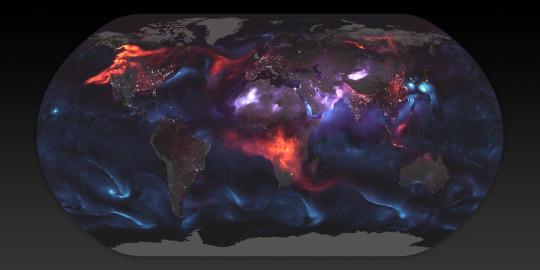
Aerosols are all around us. From the smoke from a fire, to the dust in the wind to the salt in sea spray — these solid particles and liquid droplets are always swirling in our atmosphere, oftentimes unseen.
The Goddard Earth Observing System Forward Processing (GEOS FP) model uses mathematical equations to model what is happening in our atmosphere. The inputs for its equations — temperature, moisture, wind, etc. — come from our satellites and ground sensors.
This visualization was compiled on Aug. 24, 2018 — obviously a busy day for aerosols in our atmosphere. Swirls of sea salt (indicated by blue) reveal typhoons Soulik and Cimaron heading straight towards South Korea and Japan. A haze of black carbon (indicated by red) suffuse from agricultural burning in Africa and large wildfires in North America. And clouds of dust (indicated by purple) float off the Sahara desert.
1. Camp Fire

With nearly a hundred fatalities, hundreds of thousands of acres burned and billions of dollars of damage, the world watched in horror as Camp Fire grew to become the most destructive California wildfire in recorded history.
This image was captured on Nov. 8, 2018 by OLI on Landsat 8 on the same day Camp Fire ignited. It consolidates both visible light and shortwave-infrared light in order to highlight the active fire. Strong winds and dry conditions literally fanned the flames and spread this wildfire like a rash.
This image has not only become the iconic portrait for Camp Fire, it is also sobering representation of how quickly a fire can grow out of control in a short amount of time. Even from space, you can almost smell the massive plumes of smoke and feel the heat of the fires.
Whether you realize it or not, our Earth satellite missions are collecting data everyday in order to monitor environmental changes and prepare for natural disasters. If your interest is piqued by this list, head over to the Earth Observatory. The Earth Observatory updates daily with fresh, new content — brought to you by none other than our eyes in the sky.
Make sure to follow us on Tumblr for your regular dose of space: http://nasa.tumblr.com
#NASA#Earth#satellite images#space#earth science#Earth satellite#natural disaster#wildfires#aerosols#glacier#river#erosion#volcano#hurricane#infrared#sea#sky#satellite#lake#storm#geography#smoke#camp fire#florence#hurricane florence
7K notes
·
View notes